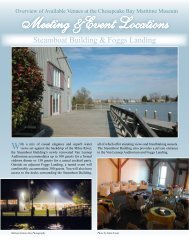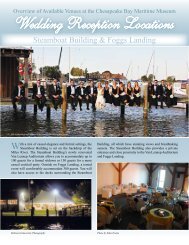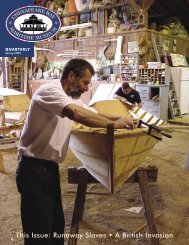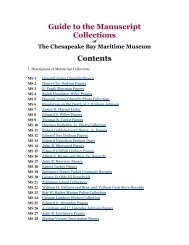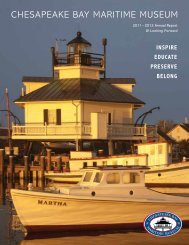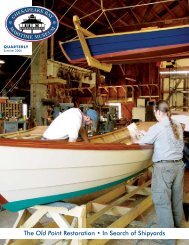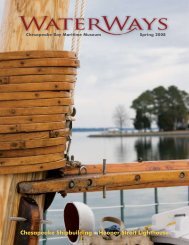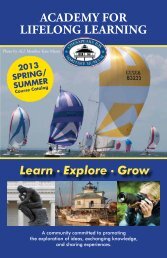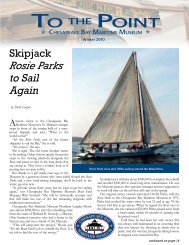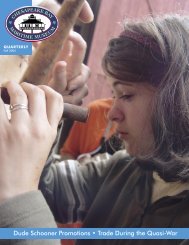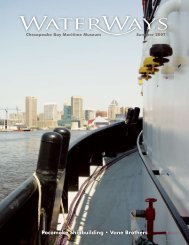Fall 2008 - Chesapeake Bay Maritime Museum
Fall 2008 - Chesapeake Bay Maritime Museum
Fall 2008 - Chesapeake Bay Maritime Museum
Create successful ePaper yourself
Turn your PDF publications into a flip-book with our unique Google optimized e-Paper software.
<strong>Chesapeake</strong> <strong>Bay</strong> <strong>Maritime</strong> <strong>Museum</strong> <strong>Fall</strong> <strong>2008</strong><br />
Maple Hall • Voices of the <strong>Chesapeake</strong> <strong>Bay</strong>
NEW ENGLAND ISLANDS<br />
Boston<br />
Plymouth<br />
<strong>Fall</strong><br />
River<br />
New<br />
Providence Bedford<br />
Bristol<br />
Newport<br />
Block<br />
Island<br />
Cape Cod<br />
Martha's<br />
Vineyard Nantucket<br />
1-800-814-6880<br />
Call for your Free Brochure<br />
<br />
e New England Islands<br />
Forged from the forces of retreating glaciers, the harbors, bays and islands of<br />
New England o er discovery and stunning beauty around every bend. Home<br />
to puritans and pirates, pilgrims and patriots, New England’s history is a<br />
tapestry woven rich in signi cance and fascinating details.<br />
Now it’s your turn to explore this cornerstone of America while cruising on the<br />
newest small cruise ship in the world. Our ships accommodate just 100 guests, a<br />
perfect way to arrive at the heart of it all.<br />
You’ll experience eight days of smooth water, beauty, culture and history,<br />
all while enjoying the camaraderie of fellow passengers and the exemplary<br />
personal attention that is the hallmark of American Cruise Lines.<br />
Small-Ship Cruising Done Perfectly<br />
8 Day/7 Night Cruise<br />
Martha’s Vineyard Nantucket Island New Bedford Block Island Newport Providence
St Michaels Office: 210 S. Talbot Street<br />
TALBOT COUNTY, MARYLAND<br />
We have the area’s finest waterfront building sites...Ranging from 3 to 196 acres...<br />
Priced from $699,000 to $7.9 million.<br />
BROAD CREEK<br />
Exceptional “French Country” home sited on 8 wooded<br />
acres near St. Michaels. Dock provides 6’ MLW. $2,950,000<br />
ST. MICHAELS HARBOR<br />
Attractive 4 BR. “Acorn” cedar contemporary home on a<br />
double waterfront lot. Over 650’ of shoreline! $995,000<br />
Tom Crouch 410.310.8916<br />
Debra Crouch 410.924.0771<br />
Office 410.822.3456<br />
www.cbmove.com/TomandDebra<br />
Tom and Debra Crouch<br />
“Specializing in Fine<br />
Talbot County Properties”<br />
TRED AVON RIVER<br />
Just completed...State-of-the-art 7000+ sq. ft. home facing<br />
south. New dock and waterside pool. $3,450,000<br />
MILES RIVER<br />
Riverview Terrace...”Move in” 4 BR, 3 bath home provides<br />
breath-taking water views. Private dock w/lift. $1,500,000
On the Cover<br />
WaterWays<br />
<strong>Fall</strong> <strong>2008</strong><br />
Volume 6 Number 2<br />
Editor<br />
Michael Valliant<br />
editor@cbmm.org<br />
Graphic Design/Photography<br />
Rob Brownlee-Tomasso<br />
Contributors<br />
Julie Barnett<br />
Dick Cooper<br />
Robert Forloney<br />
Pete Lesher<br />
Kate Livie<br />
Melissa McLoud<br />
Stuart Parnes<br />
Kate Rattie<br />
Lindsley Rice<br />
<strong>Chesapeake</strong> <strong>Bay</strong> <strong>Maritime</strong> <strong>Museum</strong><br />
Navy Point, P.O. Box 636<br />
St. Michaels, MD 21663-0636<br />
410-745-2916 Fax 410-745-6088<br />
www.cbmm.org editor@cbmm.org<br />
The <strong>Chesapeake</strong> <strong>Bay</strong> <strong>Maritime</strong> <strong>Museum</strong> is a private<br />
not-for-profit 501(c)(3) educational institution. A<br />
copy of the current financial statement is available<br />
on request by writing the Vice President of Finance,<br />
P.O. Box 636, St. Michaels, MD 21663 or by calling<br />
410-745-2916 ext. 238. Documents and information<br />
submitted under the Maryland Charitable Solicitations<br />
Act are also available, for the cost of postage and<br />
copies, from the Maryland Secretary of State, State<br />
House, Annapolis, MD 21401, 410-974-5534.<br />
WaterWays is printed on 50% recycled<br />
paper (25% post-consumer waste) using<br />
eco-friendly vegetable oil based inks.<br />
Detail of an aerial photograph of Poplar<br />
Island taken by Hunter H. Harris. The work<br />
to rebuild Poplar Island undertaken by the<br />
U.S. Army Corps of Engineers can be seen<br />
prominently from the air. Harris’s photos are<br />
being paired with photos of the <strong>Bay</strong> from 75<br />
years ago by H. Robins Hollyday as part of<br />
a new exhibit, “The <strong>Bay</strong> From Above.” For<br />
more information, see pages 14-15.<br />
Summertime, and the livin’ was…<br />
well, interesting<br />
A quick cruise on the Miles River or a walk along St. Michaels’ main<br />
street this summer was all it took to recognize that things were unusually<br />
quiet. “End of Season Sale” signs went up early in the shops, the marinas<br />
had empty slips, and marketing gurus invented new terms like “stay-cation.”<br />
Here at the <strong>Museum</strong>, we saw a definite slowing of midweek visitors. It’s too<br />
soon to know for sure if this is a temporary reaction to gasoline prices and<br />
the housing slump or the beginning of a real change in American’s traveling<br />
habits, but the situation has certainly gotten our attention.<br />
<strong>Museum</strong>s like CBMM were established as destinations, special places<br />
to visit (by car) and to explore. As museums, we have been the providers of<br />
unique personal experiences, bringing visitors from near and far face-to-face<br />
with the real stuff of history. As businesses, we have been the engines of the<br />
nationwide Heritage Tourism movement and the anchors for our local retail<br />
and hospitality industries.<br />
Now, suddenly, things are changing. I hear my colleagues asking, “What<br />
if the unthinkable happens, and Americans actually decide to drive less?<br />
How will we survive?” I could answer by noting how fortunate we are that<br />
CBMM is located just a tank away from three major metropolitan centers;<br />
but what I really want to say is, “We are asking the wrong question.” The<br />
challenge isn’t what if; it’s what now? And I think the answer is that it depends<br />
on how heavily we rely on tourism.<br />
I am very optimistic about CBMM’s ability not just to survive but to<br />
thrive, because we have an exceptionally well-balanced base of support.<br />
Tourist admissions provide less than 20 percent of our total annual revenue,<br />
compared to 21 percent from endowment and 25 percent from earned income.<br />
The largest single segment of support actually comes from you, our<br />
members: 30 percent from combined membership dues and Annual Fund.<br />
Compared to many of our colleagues, this is a very healthy formula, and it<br />
puts us in a strong position for the future.<br />
In a recent study of historic sites organized by the National Trust for<br />
Historic Preservation, experts suggested that the old business model—based<br />
on revenues from cultural tourism—is no longer valid. The model that needs<br />
to replace it is one based on affinity groups. In other words, we better start<br />
focusing on our members, not our one-time visitors. Are we providing our<br />
members with what they want and need from us? Are we building loyalty<br />
and involvement among our members? The answers better be YES.<br />
This is where you can really help. In October, replacing the long-running<br />
OysterFest, CBMM will be hosting its first Members’ Day. This is an event<br />
designed especially for you—an opportunity to go behind the scenes, meet<br />
with staff and other members, take part in special programs and activities, and<br />
talk with us about the future of your museum. This will be a family affair, with<br />
programs for all ages, and we especially encourage you to bring friends who<br />
might become new members. More details follow<br />
in this issue. Please mark your calendars for<br />
October 18 and come for the day. Rain or shine,<br />
I promise you it will be worth the trip.<br />
Stuart L. Parnes, President<br />
sparnes@cbmm.org
(Above) Families try their hand<br />
at fishing and chicken-necking<br />
for crabs at the first annual<br />
<strong>Chesapeake</strong> Folk Festival.<br />
Departments<br />
To the Point 8<br />
Calendar 11<br />
Wood Works 13<br />
Mystery Answers 22<br />
Features<br />
<strong>Chesapeake</strong> Folk Festival<br />
On July 26, the <strong>Museum</strong> introduced a festival focused on the <strong>Bay</strong>’s<br />
living traditions, highlighting communities and people living and<br />
working on the <strong>Chesapeake</strong>.<br />
The <strong>Bay</strong> From Above<br />
CBMM’s next big exhibition juxtaposes aerial photographs of the<br />
<strong>Chesapeake</strong> <strong>Bay</strong> from 75 years ago with present day views to show<br />
the changes in landscape, waterfront and <strong>Bay</strong> spaces.<br />
Voices of the <strong>Chesapeake</strong><br />
From a popular radio show to a CD of <strong>Bay</strong> songs and, now, a book<br />
chock full of <strong>Bay</strong> voices and perspectives, Michael Buckley has<br />
quickly become the <strong>Bay</strong>’s leading oral historian. By Michael Valliant<br />
Attic Treasures<br />
Contents<br />
Maple Hall in Claiborne holds the stories and secrets of 150 years<br />
of the Tunis, Cockey and Cooke families. Boxes full of documents,<br />
photographs and artifacts make for historic treasures. By Dick Cooper<br />
6<br />
14<br />
16<br />
19<br />
5
6<br />
Children visit a tent full of kids’ activities during the <strong>Chesapeake</strong><br />
Folk Festival, some making their own crabbing permits before<br />
trying their hand at chicken-necking and fishing off the dock.<br />
Boat builder Dave McQuay shares his memories of log canoe sailor<br />
Jimmy Wilson as part of the “Shore Stories” narrative stage.<br />
First<br />
<strong>Chesapeake</strong><br />
You never know what to expect from a first-time event<br />
or what will happen when you change a long-standing festival.<br />
In the case of the first <strong>Chesapeake</strong> Folk Festival,<br />
which was held on Saturday, July 26, the result was success<br />
on all fronts.<br />
Attendance for the day topped 2,000 visitors—something<br />
the former summer festival for CBMM never accomplished—and<br />
the diversity of the crowd and their enthusiastic<br />
comments about the day and the event signaled a job<br />
well done.<br />
“The acid test of a good event is the sense of involvement,<br />
ownership, and downright comfort, which was palpable,”<br />
said Elaine Eff of Maryland Traditions, the lead sponsor of<br />
the festival.<br />
The day boasted near-perfect weather and outdoor and<br />
indoor activities for visitors of all ages. Community conversations,<br />
boat rides, films, great music and traditional<br />
demonstrations—dipnet making, boat building, pottery and<br />
the secrets to a delicious Smith Island Cake—all made for<br />
an exceptional day at CBMM.<br />
Festival-goers congregate under the Hooper Strait Lighthouse as<br />
they prepare to board the skipjack H. M. Krentz for a boat ride.
Folk Festival<br />
Starts a New Tradition<br />
Festival-goers noticed a difference in both the event<br />
and the crowd in attendance:<br />
“We loved the variety of things to do. It was especially<br />
nice to see the diversity of visitors,” said Rosemary Fasolo<br />
of St. Michaels. “I don’t recall seeing this to that extent at a<br />
CBMM event in the past.”<br />
And the Folk Festival was a hit with the local community<br />
as well.<br />
“What a day! You guys exceeded every boundary on<br />
Saturday! I never saw or talked to so many impressed<br />
people in one place,” said Julie McCahill, chair of the<br />
<strong>Museum</strong>’s Program Committee. “I ran into some St. Michaels<br />
friends who have lived here all their lives and rarely<br />
if ever had visited CBMM but came on Saturday and immediately<br />
joined. ‘Never knew they did stuff like this—<br />
this is cool!’”<br />
The <strong>Chesapeake</strong> Folk Festival was funded by Maryland<br />
Traditions and media sponsor What’s Up? Publishing. Plans<br />
are already underway for the 2009 festival, which promises<br />
to top this year's event <br />
The “Fish Tales/Net Cafe” gave visitors as chance to meet<br />
fisherman and watermen and learn about their work and tools.<br />
Shipwright and potter Marc Barto shows off his non-boat-building<br />
skills as he instructs a young visitor on how to throw<br />
a pot on a wheel. Photo by Kathy Stevens.<br />
The Zionaires, a popular gospel group from Princess Anne, Md.,<br />
took center stage on the Tolchester Beach Bandstand.<br />
7
8<br />
To the Point<br />
National Fish and Wildlife<br />
Foundation Awards CBMM<br />
$100,000 Grant<br />
The <strong>Chesapeake</strong> <strong>Bay</strong> Program and the National Fish<br />
and Wildlife Foundation (NFWF) recently awarded CBMM<br />
a $100,000 matching grant for construction of 12,670<br />
square feet of living shoreline on the <strong>Museum</strong>’s waterfront.<br />
CBMM’s project was one of 34 environmental projects in<br />
the <strong>Chesapeake</strong> <strong>Bay</strong> watershed awarded funding through the<br />
<strong>Chesapeake</strong> <strong>Bay</strong> Small Watershed Grants program, which<br />
provides grants to organizations and municipal governments<br />
working to improve the condition of their local watershed.<br />
NFWF awarded a total of $2.1 million in grants for projects<br />
that will protect 3,400 acres of land, restore approximately<br />
15 miles of streams and plant more than 160 acres of marsh<br />
and wetland grasses.<br />
Staff from the <strong>Chesapeake</strong> <strong>Bay</strong> Trust use a seine net to sample<br />
the diversity of species before a living shoreline is constructed at<br />
the <strong>Museum</strong>.<br />
“Each project receiving a Small Watershed Grant this<br />
year is a vital component of the broad partnership of organizations<br />
working to restore the <strong>Bay</strong> and its local waterways,”<br />
said Jeffrey Lape, director of the <strong>Chesapeake</strong> <strong>Bay</strong> Program.<br />
CBMM will use the NFWF funds to construct a new<br />
marsh to treat storm water runoff from impervious surfaces<br />
before it reaches tidal waters. The new marsh will enhance<br />
the shoreline and provide for vegetative shoreline erosion<br />
control and marsh edge protection along the <strong>Museum</strong>’s Miles<br />
River shoreline.<br />
The project will be designed to eliminate point source<br />
storm water discharge and construct a low profile stone containment<br />
structure (sill) along 622 linear feet of shoreline in<br />
the Miles River Watershed. In addition, approximately 0.3<br />
acres of new marsh will be constructed and protected.<br />
Sea grass grating bridging a vegetated swale to allow<br />
sunlight to reach the plantings below will replace a portion<br />
of the <strong>Museum</strong>’s existing boardwalk. This living shoreline<br />
will become a new outdoor living classroom that will be<br />
viewed and interpreted to the <strong>Museum</strong>’s 80,000 annual visitors<br />
including more than 11,000 Maryland and Mid-Atlantic<br />
students from public, private and home schools.<br />
“Locally driven conservation projects (like the one proposed<br />
by the <strong>Chesapeake</strong> <strong>Bay</strong> <strong>Maritime</strong> <strong>Museum</strong>) not only engage<br />
communities in restoring their local streams and watersheds,<br />
collectively, they are key to restoring one of the country’s most<br />
vital natural resources – the <strong>Chesapeake</strong> <strong>Bay</strong>,” noted Mike Slattery,<br />
director of NFWF’s Eastern Partnership Office.<br />
CBMM Participating<br />
in National Economic<br />
Impact Study<br />
CBMM is one of 16 museums from the across the country<br />
chosen to participate in a three-year study of the economic<br />
impact of museums on their communities. The North<br />
Adams, Mass.-based Center for Creative Community Development<br />
(C3D) launched the study, “<strong>Museum</strong>s in the Neighborhood,”<br />
in 2006.<br />
“Cultural organizations, even relatively small ones, impact<br />
their neighborhoods and their communities. They have<br />
an economic impact on their community through their annual<br />
budget as it circulates through the local economy. But<br />
they also impact their community by making it a more attractive<br />
place to live, by offering educational programming, and<br />
by being a local gathering place,” notes Stephen Sheppard,<br />
Ph.D., professor of economics at Williams College and director<br />
of the C3D project.<br />
The project will provide CBMM and the other museums<br />
participating in the study with a suite of tools to evaluate their<br />
general impact or the success of programs that target community<br />
members. Funding for the research project has come from<br />
the Ford Foundation through its “Shifting Sands: Art, Culture,<br />
and Neighborhood Change” initiative, with assistance from<br />
Partners for Livable Communities, the Institute for <strong>Museum</strong><br />
and Library Services, and Williams College.<br />
ALL Offers New Courses &<br />
New Interview Series<br />
The Academy for Lifelong<br />
Learning (ALL), which is sponsored<br />
by the <strong>Chesapeake</strong> <strong>Bay</strong> <strong>Maritime</strong><br />
<strong>Museum</strong>, will offer the first<br />
of a new interview series, “Distinguished<br />
Residents of the Eastern<br />
Shore,” and 14 courses for the fall<br />
<strong>2008</strong> semester.<br />
The first program of the new series<br />
will feature an interview with<br />
Senator Birch <strong>Bay</strong>h is the<br />
first in a new interview<br />
series for ALL.<br />
Senator Birch <strong>Bay</strong>h (former U.S.<br />
Senator-Indiana) by Wilson Wyatt,<br />
Jr. It will be held on Monday, No-
vember 10, from 1:30 to 3:30 p.m. at the MEBA Engineering<br />
School Auditorium. The discussion will trace Senator <strong>Bay</strong>h’s<br />
involvement in the U.S. Senate during the period 1963-1981,<br />
when he was instrumental in the passage of Title IX, initiated<br />
two Constitutional amendments and participated in landmark<br />
civil rights legislation.<br />
Other ALL courses cover a wide range of subjects including<br />
digital photography, French literature, Renaissance<br />
art, gardening, history and literature. Classes will begin September<br />
11 and run through November 25.<br />
For a copy of the fall <strong>2008</strong> ALL catalog or further information,<br />
call Helen Van Fleet, 410-745-2916, or visit the ALL<br />
website at www.cbmm.org/all.html.<br />
New Board Officers & Members<br />
Members of the CBMM Board of Governors tour the Hooper Strait<br />
Lighthouse. Pictured (L-R) are Chairman of the Board Robert Perkins,<br />
new board member Robin Gordon, volunteer tour guide Andy<br />
Flanagan, new board member Langley Shook, returning board<br />
member Candy Backus, and board members Douglas Jurrius and<br />
Bruce Bedford.<br />
The <strong>Museum</strong> is pleased to announce new officers and members<br />
of its Board of Governors. New officers of the Board are:<br />
Chair Robert A. Perkins of St. Michaels; Vice-Chair<br />
Alan R. Griffith of Centreville; Secretary D. Ted Lewers of<br />
Easton; and Treasurer Joseph E. Peters of Easton. Newly<br />
elected to the Board of Governors are: Candace Carlucci<br />
Backus of Easton; Stuart A. Clarke of Easton; Robin Gordon<br />
of St. Michaels; Tom D. Seip of Easton; Langley R. Shook<br />
of Easton; Benjamin C. Tilghman, Jr. of Centreville; and<br />
Bruce Wiltse of Claiborne.<br />
“We are excited to have a great class of new Board members,”<br />
says CBMM president Stuart Parnes. “Each of them<br />
brings much life experience and expertise to the <strong>Museum</strong>, and<br />
they have already gotten involved in projects and planning,<br />
and sitting on committees.”<br />
Dr. John Miller: A Class Act<br />
John H. Miller, Ph.D., ended his 10-year tenure with<br />
CBMM in September. John came to the <strong>Museum</strong> from Carnegie<br />
Mellon University in Pittsburgh, Pa., where he was a<br />
major gifts officer. John and his<br />
family spent time on a family farm<br />
in McDaniel, and at the urging of<br />
then CBMM Executive Director<br />
John Valliant, he signed on to help<br />
build fundraising efforts during the<br />
capital “Campaign for Preserving<br />
the Heritage of the <strong>Bay</strong>,” which ran<br />
from 1997 through 2001.<br />
John Miller<br />
Thanks in large part to Miller’s<br />
tireless fundraising, the campaign<br />
went on to raise more than $18 million, exceeding its goal.<br />
In post-campaign fundraising, John helped CBMM set and<br />
re-set record goals in its Annual Fund.<br />
Beyond the class he has brought to development at the<br />
<strong>Museum</strong>, John has also held classes—many of them for<br />
CBMM’s Academy for Lifelong Learning. Drawing on his<br />
experience as a former adjunct professor of English while<br />
at Carnegie Mellon, John has co-taught literature courses<br />
for more than five years for ALL. His classes have been<br />
widely subscribed and have become perennial favorites<br />
with students.<br />
John will continue his affiliation and his collaboration<br />
with John Ford in team teaching for ALL, as well as<br />
teach literature at American University and other regional<br />
academic institutions. He and his wife, Emily, will remain<br />
residents of Easton.<br />
CBMM Staff News<br />
Kathleen (Kate) Rattie has been<br />
named vice president of advancement,<br />
overseeing CBMM’s fundraising, membership,<br />
government relations, marketing<br />
and communications efforts. Kate joined<br />
the <strong>Museum</strong> in 2006 as director of development.<br />
She brings more than 30 years<br />
Kate Rattie<br />
experience in fundraising, marketing, and<br />
public relations to her new role. Kate is a<br />
graduate of American University and completed masters degree<br />
work at New York University and Fordham University.<br />
Lynne Phillips has joined CBMM as<br />
collections manager. She holds masters<br />
degrees in history from the University<br />
of Houston-Clear Lake and in museum<br />
studies from John F. Kennedy University<br />
in San Francisco. Lynne worked for the<br />
Aircraft Carrier Hornet <strong>Museum</strong> and the<br />
Walt Disney Family Foundation’s new<br />
museum in the Presidio of San Francisco<br />
prior to her move to CBMM.<br />
Lynne Phillips<br />
Kate Livie, an Eastern Shore native, is the <strong>Museum</strong>’s new<br />
youth and adult programs coordinator. Kate holds a bachelors<br />
degree from Towson University and a master of fine arts degree<br />
in American decorative arts from the Parsons School of<br />
Design. She has worked for the National Park Service in The<br />
White House Historic Preservation Division, as a historic in-<br />
9
To the Point<br />
Kate Livie<br />
terpreter at George Washington’s Mount<br />
Vernon and as historic outreach coordinator<br />
for Sultana Projects in her hometown<br />
of Chestertown, Md.<br />
Ida Heelan has<br />
joined CBMM as<br />
events coordinator.<br />
She and her husband<br />
recently moved to St.<br />
Michaels from New York, where Ida had<br />
extensive experience in event planning<br />
and hospitality management, working<br />
most recently for the North Ritz Club and<br />
Ida Heelan<br />
Fox Hollow. At CBMM, she coordinates festivals, special<br />
events, weddings, and corporate and private grounds rentals.<br />
A Day for CBMM Members!<br />
Make plans now to come to the <strong>Museum</strong> on Saturday, October<br />
18, from 10 a.m. to 4 p.m. The first annual Members’<br />
Day celebration is our way to thank you for your support, and<br />
to showcase some of the new programs, exhibitions and artifacts<br />
in our collection. It promises to be a day of fun and<br />
enjoyment, rain or shine!<br />
Members’ Day will be the first chance to explore a new exhibition<br />
in the Steamboat Building, “The <strong>Bay</strong> From Above,”<br />
which features aerial photography of the <strong>Chesapeake</strong>, then and<br />
now. The exhibit will pair photos from H. Robins Hollyday,<br />
shot between the 1930s and 1950s, with contemporary photographs<br />
by Hunter Harris. The similarities and differences<br />
in the landscapes and the water provide an insightful glimpse<br />
The Members’ Day celebration on Saturday, October 18, will provide<br />
a number of opportunities to get out on the water.<br />
into the state of the <strong>Bay</strong>. Photographer Hunter Harris will be<br />
on hand to answer questions throughout the day.<br />
The day will also include boat rides on vessels in CBMM’s<br />
floating fleet and boat building demonstrations in our working<br />
Boat Yard. There will be food and drinks available and<br />
activities for kids throughout the campus.<br />
Members’ Day will also include live music, special discounts<br />
in the <strong>Museum</strong> Store, as well as prizes and drawings<br />
for CBMM members. Stay tuned and check our website,<br />
www.cbmm.org, for more information, but make plans now<br />
to come to St. Michaels and the <strong>Museum</strong> on October 18! <br />
CBMM <strong>Museum</strong> Store<br />
A fantastic selection<br />
of jewelry, books,<br />
clothing, fine art,<br />
pottery, and model kits.<br />
CBMM Members <strong>Museum</strong> Store coupon good for<br />
25% OFF<br />
Photo by Bill Kepner<br />
all regularly<br />
priced merchandise,<br />
one-time use.<br />
You must spend at least $25 and be a <strong>Museum</strong> member to redeem this coupon. Offer good through<br />
October 20, <strong>2008</strong>. Offer applies only to regularly priced merchandise. One-time usage. Cannot be combined<br />
with any other offer or discount. You must present this coupon to receive the discount.
September<br />
Building a Ship in a Bottle<br />
Saturday, September 20, 9:30am-4:30pm<br />
Sunday, September 21, 10:00am-4:00pm<br />
Location: Van Lennep Auditorium<br />
Fee: $175 CBMM members, $200 non-members<br />
Join model shipwright Jim Wortman of Talbot Street Ship<br />
Shop to explore the secrets of building a ship in a bottle.<br />
Build your own skipjack model, then place it in a bottle<br />
using traditional methods. This two-day class will take inspiration<br />
from some of the best contemporary marine art<br />
presented by members of the American Society of Marine<br />
Artists. To “insure” success, the class will be limited<br />
to six. A supply list will be sent with your confirmation.<br />
Maryland Lighthouse Challenge<br />
September 20 & 21, 8am-6pm<br />
Participate in Maryland’s 6th anniversary Lighthouse<br />
Challenge by visiting lighthouses around the state. Stop<br />
by CBMM’s own Hooper Strait Lighthouse! For more information,<br />
visit www.cheslights.org/challenge.htm.<br />
Apprentice for a Day –<br />
Steam Bending and Laminating<br />
(1 day) September 27 or 28, 10am-5pm<br />
Fee: $60 CBMM members, $75 non-members<br />
Learn how to form wood into curved shapes either by<br />
steaming and bending or by laminating several layers.<br />
Calendar<br />
<strong>Fall</strong> <strong>2008</strong><br />
Model Making Workshop:<br />
Lapstrake Skiff<br />
September 26, 6 – 9pm;<br />
September 27 & 28, 9am – 5pm<br />
Location: Mitchell House on CBMM campus<br />
Fee: $80 CBMM members, $90 non-members<br />
Build a 10-inch lapstrake crabbing skiff model with<br />
CBMM’s Model Boat Guild instructors. Participants<br />
gain model boat building skills while exploring a traditional<br />
maritime craft. Participants should be at least<br />
12 years old.<br />
Star Gazing Cruise<br />
September 27, 8-11pm<br />
Join us aboard our buy boat Mister Jim while raising<br />
your eyes to the mariner’s night sky. Delmarva Star<br />
Stargazers representatives will join us on the water<br />
as we discuss constellations, astronomy and celestial<br />
events. The entire family will enjoy stargazing on the<br />
Miles River. Meet at Admissions Building. CBMM Members<br />
$25, Non-Members $30.<br />
October<br />
26th Mid-Atlantic<br />
Small Craft Festival<br />
October 4, 10am – 5pm<br />
One of the nation’s premier small craft events! Hundreds<br />
of amateur and professional boat builders and<br />
enthusiasts come from all over the region to display<br />
their skiffs, kayaks, and canoes. Take part in demonstrations<br />
and workshops, or simply chat with the owners<br />
and watch these one-of-a-kind vessels race. Included<br />
with <strong>Museum</strong> admission.<br />
11<br />
9
Viking to Victorian<br />
Tuesday October 14th at 4:00 PM<br />
CBMM Members $5, Non-members $8<br />
Olaf Engvig, a well-known maritime scholar, author<br />
and captain of historic vessels, will talk about his latest<br />
book, Viking to Victorian: Exploring the Use of Iron<br />
in Ship Building. The book covers a 1,000-year span of<br />
iron as marine technology and includes thrilling firsthand<br />
accounts of open sea exploration in a small open<br />
1863 longboat—completely original including the sail.<br />
Engvig’s credentials include a remarkable connection to<br />
authentic 19th century vessels and techniques. Astonishingly,<br />
Engvig learned square-rig sailing directly from<br />
a teacher born in the 19th century whose knowledge<br />
was acquired the traditional way—passed along century<br />
after century directly from the early Vikings.<br />
CBMM Members’ Day<br />
October 18, 10am – 4pm<br />
Special day for our members, in conjunction with<br />
the opening of the new exhibition, “The <strong>Bay</strong> From<br />
Above.” Boat rides, kids’ activities, special programs,<br />
refreshments.<br />
Apprentice for a Day –<br />
Using & Sharpening Hand Tools<br />
(1 day) October 25 or 26, 10am – 4pm<br />
Fee: $60 CBMM members, $75 non-members<br />
Learn how to keep a sharp edge on your hand tools,<br />
how to properly use these tools and how to decide<br />
which tool is right for the job.<br />
Model Making Workshop:<br />
Half-hull Model<br />
October 25 & 26, 9am – 5pm<br />
Location: Mitchell House on CBMM campus<br />
Fee: $80 CBMM members, $90 non-members<br />
Work with the <strong>Museum</strong>’s Model Guild instructors to create<br />
a Pride of Baltimore half-hull model. The end product<br />
will become a beautiful wall-hanging in your home.<br />
Participants should be at least 12 years old.<br />
Academy for Lifelong Learning (ALL)<br />
<strong>Fall</strong> Courses<br />
Distinguished Residents of the Eastern<br />
Shore Featuring Senator Birch <strong>Bay</strong>h<br />
Monday, Nov. 10 • 1:30-3:30pm<br />
Jack Shall Have His Jill<br />
Wednesdays, Sept. 17-Oct. 22 • 1:30-3pm<br />
Great Decisions<br />
Discussion<br />
Program<br />
Fridays,<br />
Sept. 19-Nov. 7<br />
2:30-4:30pm<br />
The Quantum<br />
World<br />
Thursdays,<br />
Sept. 11-Oct. 16<br />
3-4:30pm<br />
The Question<br />
of God<br />
Wednesdays,<br />
Sept. 17-Nov. 12<br />
1-2:30pm<br />
The Universe as a Metaphor<br />
Tuesdays, Sept. 16-Nov. 11 • 10:30am-noon<br />
Building and Enjoying Marine Models<br />
Thursdays, Oct. 2-Oct. 23 • 10:30am-noon<br />
Tuesdays at the Movies<br />
Tuesday, Oct. 7 & Tuesday, Nov.4 • 1-4pm<br />
French Texts in Translation<br />
Thursdays, Oct. 16, 23 & Nov. 6, 13 • 1:30-3:30pm<br />
Visit Poplar Island<br />
Thursday, Oct. 16 • 9am-noon<br />
Digital Photography (Part I: The Basics)<br />
Tuesdays, Oct. 7-28 • 10:30am-noon<br />
Digital Photography (Part II: Photo-Editing)<br />
Tuesdays, Nov. 4-25 • 10:30am-noon<br />
French Impressionism<br />
Saturdays, Oct. 11-Nov. 15 • 10:30am-noon<br />
<strong>Fall</strong> Gardening<br />
Monday, Sept. 22 • 10:30-11:30am<br />
Holiday Decorating<br />
Monday, Nov. 17 • 10:30-11:30am<br />
A Tour of the <strong>Chesapeake</strong> <strong>Bay</strong> Foundation<br />
Wednesday, Oct. 22 • 10am-noon<br />
To register for classes or for more information visit<br />
www.cbmm.org/all.html or call 410-745-2916.
Shipwright Dan Sutherland works on the new Lawley<br />
tender for the restored yacht Elf.<br />
New life for the Elf<br />
While work on much of CBMM’s floating fleet of historic<br />
vessels has settled into the “routine” maintenance associated<br />
with old wooden boats, inside the Boat Shop, things are anything<br />
but routine. Boat Yard Program Manager Dan Sutherland<br />
and the weekend Apprentice for a Day participants have<br />
been constructing a replica of a Lawley-built (Boston) tender<br />
for the newly restored yacht, Elf.<br />
Elf is a boat with a rich history and direct ties to the <strong>Museum</strong>.<br />
Launched in 1888 by George Lawley & Sons in Boston,<br />
Elf was built for $3,500 as a state-of-the-art racing yacht<br />
for Mr. William H. Wilkinson. Elf’s unique and impressive<br />
sailing rig has long since disappeared from North American<br />
waters. She had an active career as a gaff topsail rigged racing<br />
yacht, before pioneering off-shore yacht cruising in 1893,<br />
by becoming the first small craft to cruise successfully roundtrip<br />
from Marblehead, Mass., to Halifax, Nova Scotia.<br />
After her racing career ended, Elf regularly cruised up<br />
and down the northeast coast and later between New England<br />
the Bahamas. During the first World War, her externally fitted<br />
lead ballast was given up to support the war effort, and<br />
eventually a steel keel was added. In addition, her sail area<br />
was reduced and her rigging was modified to make her easier<br />
(and safer) to handle.<br />
In 1932, Elf was purchased by CBMM founders Gus and<br />
Vida Van Lennep. Vida fondly recalls Elf and her tender, and<br />
the Van Lenneps have been staunch supporters of the boat’s<br />
restoration. In 1971, the boat was acquired by Rick Carrion,<br />
founder of the Classic Yacht Restoration Guild, who has<br />
championed her restoration under the expertise of master<br />
boat builder Graham Ero, in Still Pond, Maryland. Thanks to<br />
the work of these individuals, Elf is on the National Register<br />
of Historic Places, fully restored and sailing today. She was<br />
docked at CBMM for much of August and has taken sails on<br />
the Miles River.<br />
Carrion, equipped with photos and recollections of Mrs.<br />
Van Lennep, commissioned CBMM to build a replica of Elf’s<br />
Lawley-built tender. The rowing lapstrake skiff is 9’ 3” and is<br />
planked and ribbed out of sassafras. Mrs. Van Lennep, now<br />
98, recently visited CBMM to see Elf again, the newly built<br />
tender and her beloved CBMM. Once completed and dedicated,<br />
the tender will be named, Vida.<br />
CBMM founder Vida Van Lennep (seated) was on hand<br />
to see her former boat Elf and its new tender.<br />
Around the Boat Yard<br />
Elf, shown at left, will<br />
return to CBMM’s docks<br />
for the Mid-Atlantic Small<br />
Craft Festival on Saturday,<br />
October 4. To follow her<br />
progress and see more photos<br />
of Elf, visit the Classic<br />
Yacht Restoration Guild’s<br />
website at www.cyrg.org.<br />
Vessel Maintenance Manager Marc Barto reports that late<br />
summer and fall work will include building a new rudder for<br />
CBMM’s dory boat as well as cycling through various seasonal<br />
vessel haul-outs. Barto and Floating Fleet Assistant Don<br />
MacLeod will be gearing up for a significant fall and winter<br />
restoration project: finishing work they began last winter on<br />
the <strong>Museum</strong>’s log bugeye Edna Lockwood, a National Historic<br />
Landmark. <br />
13
14<br />
The <strong>Bay</strong> From<br />
Above<br />
How much has the <strong>Chesapeake</strong> <strong>Bay</strong> changed over<br />
the past 75 years? There are a number of ways to<br />
explore this question. One of the most effective<br />
and engaging is to take a bird’s eye view of the <strong>Bay</strong>—say,<br />
from an airplane—and look at stunning photographs taken<br />
over time.<br />
That’s the idea behind a new exhibition developed by<br />
CBMM Curator of Exhibitions Lindsley Rice. “The <strong>Bay</strong><br />
From Above: Aerial Views of the <strong>Bay</strong> Then and Now” juxtaposes<br />
the 1930s-1950s photography of H. Robins Hollyday<br />
with new photography by Hunter H. Harris, pairing<br />
views of the same stretch of the <strong>Bay</strong> region. The result is a<br />
visually arresting exhibition, one that should appeal to both<br />
watershed residents and visitors.<br />
“The <strong>Bay</strong> From Above” is a collaboration between<br />
CBMM and Harris’s Aloft Aerial Photography, in cooperation<br />
with the Historical Society of Talbot County, whose<br />
collection includes Hollyday’s photographs. Hollyday<br />
worked as a commercial photographer from the 1930s to the<br />
1950s, documenting life in Talbot County and on the Eastern<br />
Shore. Harris owns and operates his studio in Easton,<br />
where his own work focuses on land use and development.<br />
Contrasting Hollyday’s black-and-white<br />
photographs with Harris’s color images<br />
of spectacular vistas and the unique viewpoint<br />
hundreds of feet above the <strong>Bay</strong>, this<br />
exhibition provides astoundingly beautiful<br />
and startling evidence of the changes in the<br />
<strong>Chesapeake</strong>’s shoreline, farmland, and <strong>Bay</strong><br />
spaces over the last 75 years.<br />
The exhibition opens on Saturday, October<br />
18, as a part of our Members’ Day<br />
celebration and will be on display through<br />
the spring of 2009. The exhibit is supported<br />
by the Maryland Historical Trust, the National<br />
Park Service, and Verizon.<br />
(Left and above) Ferry Point, across<br />
the Choptank River from Cambridge,<br />
Md., shows some of the most familiar<br />
changes to the <strong>Chesapeake</strong> over the past<br />
75 years—development and the rip-rapping<br />
of the shore. The Route 50 bridge<br />
to Cambridge opened in 1935, extending<br />
the Eastern Shore’s accessibility by highway<br />
to Dorchester County and beyond.
(Above and right) Some <strong>Bay</strong> places haven’t changed<br />
as much as others around the watershed. The Oxford<br />
Boatyard on Town Creek in Oxford, Md. is still<br />
the site of much boat work, although it no longer<br />
launches new wooden sailboats. Recreational boating<br />
on the <strong>Bay</strong> has largely replaced boat building<br />
and other <strong>Bay</strong> industries. The A.B. Harris and Nollmeyer<br />
seafood companies no longer draw workers<br />
to this cove.<br />
(Below and right) Occasionally, the human impact<br />
on the <strong>Bay</strong> goes against the tide—sometimes literally—as<br />
the U.S. Army Corps of Engineers rebuilds<br />
Poplar Island with dredge material from Baltimore<br />
Harbor and approach channels. Settled in the 1630s<br />
and at one time totaling over 1,000 acres, the island<br />
had eroded to a few green specks and some sand<br />
bars—just 10 acres—by the 1960s. The reconstructed<br />
Poplar Island will provide a diverse wetland habitat<br />
for <strong>Chesapeake</strong> flora and fauna.<br />
15
16<br />
Photo by Jessica Earle<br />
Earl White<br />
First Mate, Skipjack Stanley Norman<br />
My father was a waterman. In water season, he<br />
worked on the water. And when that was over<br />
with, we’d go working in fields, canning factories,<br />
all that. So when I got big enough to hit the water,<br />
that’s where I been. And the first me hitting the water<br />
with my father was a’tonging, and he was taking<br />
me out when I was about 13 or 14 years old.<br />
“All my brothers were watermen. The way I<br />
got on the water was a friend of mine, during the<br />
time I was young, I was going with his daughter.<br />
The boat he was working on got so he didn’t have<br />
enough crew and he asked me did I want to go.<br />
So, I went with him and I’ve been going on the<br />
water ever since. A guy from Smith Island, a boat<br />
named Ralph T. Webster. That’s the name of the<br />
skipjack I was on. Skipjacks, schooners, and bugeyes.<br />
I worked on them all. Well, it was a lot of<br />
fun. ‘Cause when I first started there were a lot of<br />
oysters. We had plenty of oysters. We’d put 3,000,<br />
4,000 a day on a boat. That’s a lot of oysters.<br />
“Always take the word of the captain, if the<br />
captain’s wrong, that’s his fault. If he tells you to<br />
do something, you do it. Even if it’s the dumbest<br />
thing in the world. Do it. That’s his fault. If it’s<br />
wrong, if it goes wrong, it’s his fault. Ain’t but<br />
one thing the captain can tell me to do that I ain’t<br />
gonna do. If he tells me to jump overboard, I ain’t<br />
gonna do it. He’ll have to throw me overboard!<br />
“Look, let me tell you something. When<br />
you’re on the water, you’re not the boss of nothing.<br />
You just go along with it, ‘cause you can’t<br />
change it. You better believe it. You can’t change<br />
that. The wind start blowing, you can’t change it.<br />
Tide starts running wild, you can’t change that.<br />
You just have to wait it. You gotta have patience.<br />
That’s all you have to do. And realize that you<br />
can’t conquer it. Man conquer a lot of things,<br />
but he can’t conquer the water, the sun, and the<br />
wind. You can’t do it. You get that in your mind<br />
you’ll be all right.<br />
By<br />
Michael<br />
Valliant<br />
<strong>Chesapeake</strong> <strong>Bay</strong> oral historian Michael Buckley. Photo by David Harp.<br />
If you tune in to WRNR 103.1 FM on any given Sunday<br />
morning, you’re likely to hear an “old salt,” a scientist, or an<br />
activist sharing their story of a life lived on the <strong>Chesapeake</strong><br />
<strong>Bay</strong>. Making sure you hear these voices and get to know their<br />
stories has become the life work of radio DJ and oral historian<br />
Michael Buckley. With his radio show, website, and a<br />
new book, Voices of the <strong>Chesapeake</strong> <strong>Bay</strong>, Buckley is covering<br />
all bases to make sure the <strong>Bay</strong>’s comprehensive story is<br />
being told.<br />
The concept for Buckley’s radio show gelled in 1999<br />
when he met Jennifer Hicks, an environmental educator at<br />
the <strong>Chesapeake</strong> <strong>Bay</strong> Foundation. Buckley was the host of<br />
a Sunday morning radio show, and the two talked about incorporating<br />
ideas and conversations about the <strong>Bay</strong> into the<br />
program. The pieces fell together later in the year when he<br />
met Claudia Donegan and Robin Jung Brown.<br />
Donegan’s late father was a bay pilot from Baltimore,<br />
and she knew the locals and the scene in Annapolis. She<br />
was trained as a geologist and was an environmental activist<br />
for the <strong>Bay</strong>. Brown moved to Annapolis to work for
the U.S. Geological Survey Patuxent Wildlife Research<br />
Center in Laurel, Md. She worked with the local Sierra<br />
Club to create an environmental radio project called “Watershed<br />
Radio.”<br />
Buckley met Brown when she delivered the first demo<br />
of Watershed Radio to WRNR. Buckley brought up the idea<br />
for a recurring <strong>Chesapeake</strong>-based radio show, which led to a<br />
number of brainstorming meetings about possible guests and<br />
a format for the show. Brown suggested the name, “Voices of<br />
the <strong>Chesapeake</strong> <strong>Bay</strong>” for the series, and the group began with<br />
10 hour-long interviews.<br />
They decided on in-the-field style interviews, going to visit<br />
watermen, conservationists, and musicians in their element.<br />
“I do not remember us ever mapping out a strategy for<br />
how to tell the story of the <strong>Chesapeake</strong> <strong>Bay</strong> from beginning<br />
to end,” says Buckley in the epilogue to his book. “We just<br />
tried to think of people who had good stories to tell.”<br />
To date, the Voices Project has recorded more than 250<br />
oral history interviews with folks of all walks on the <strong>Bay</strong>.<br />
The diversity of perspectives and viewpoints represented is a<br />
point of pride for Buckley.<br />
“The thing I like to communicate about the Voices Project<br />
is the scope of the interviews, this method of telling stories<br />
about the <strong>Bay</strong> by seeking out a variety of perspectives,” he<br />
says. “We all tend to see life through our own particular interests.<br />
This project encourages people to look beyond themselves,<br />
to see the <strong>Bay</strong> through other eyes.”<br />
The Voices book showcases more than 50 of the interviews<br />
(three of which are excerpted here for WaterWays<br />
Magazine), illustrated with black-and-white photographs by<br />
renowned photographer David Harp. Buckley and publisher<br />
Lenny Rudow can often be found taking the book on the road<br />
to festivals, fish fries, crab feasts, and other gatherings where<br />
people come together to celebrate the <strong>Chesapeake</strong>.<br />
It was through his radio show that CBMM first encountered<br />
Buckley. His interviews with Curator Pete Lesher and<br />
former Boat Yard Manager Mike Vlahovich, which aired on<br />
WRNR, both appear in the book. And as CBMM was de-<br />
Photo by David Harp<br />
Russell Train<br />
Former Administrator,<br />
US Environmental Protection Agency<br />
Nixon was an enigma and he was strange in many<br />
ways, brilliant in many ways, effective in many<br />
ways and a disaster. He was his own worst enemy,<br />
certainly the whole Watergate fiasco was an example<br />
of that. When you’re at the pinnacle, you’re<br />
vulnerable. Maybe it’s a good lesson for the rest of<br />
us. Nixon was certainly not an environmentalist.<br />
I’ve got to say, I don’t think he understood many<br />
of the issues very well. However he knew one<br />
thing about it and that was that the people of this<br />
country were worried about the environment. I’m<br />
talking about the late 60s and the early 70s. The<br />
people of this country were worried. There were<br />
huge oil spills, there were rivers catching on fire,<br />
toxic chemical poisonings, a lot of things. It was<br />
very scary. There was rudimentary regulation;<br />
much of it was left to the states to handle. And it<br />
was plain that the federal government had to get<br />
more actively into the whole thing. Nixon seized<br />
on it. He made it a central effort of his administration,<br />
certainly in his first term. It was not only a<br />
political choice on his part, in that sense. It was a<br />
Democratic Congress whose environmental leader<br />
was Edmund Muskie. Nixon recognized Muskie as<br />
a potential Democratic candidate against him in<br />
1972. Muskie’s track record for the public was basically<br />
dealing with air and water pollution. Nixon<br />
made up his mind he was going to trump Muskie<br />
with his own issue, and I think he did. Hah—he<br />
‘stole his clothes!’ I think somebody said that, and<br />
I think it’s quite true.<br />
“Whatever the motivations were, Nixon<br />
grabbed the issue. He signed the National Environmental<br />
Policy Act into law on January 1, 1970<br />
as his first official act of the decade. A few days<br />
later he sent his State of the Union message to<br />
the Congress, and at least a third of that message<br />
dealt with the environment.<br />
17
18<br />
Photo by David Harp<br />
Mary Parks Harding<br />
Dorchester County<br />
My father was Bronza Parks. He is most famous<br />
for his skipjacks, commercial fishing boats, and<br />
fast motorboats. Counting the little ones and<br />
all, he built over 400 boats in his lifetime. The<br />
ones that are most famous, I suppose, are the<br />
skipjacks. The first one he built was the Wilma<br />
Lee, and then the Rosie Parks, Martha Lewis,<br />
and Lady Katie. The Martha Lewis was named<br />
after my mother’s mother. The Rosie Parks was<br />
named after my father’s mother. And the Lady<br />
Katie was my mother. And those boats happened<br />
to be named after my grandmothers because the<br />
boats were built for my father’s brother and also<br />
his brother-in-law.<br />
“My father first started building boats probably<br />
around 1932 or ‘33. They were built in the<br />
side yard of our home right along the county<br />
road, right at Wingate. My father had a fairly<br />
large piece of property attached to our yard<br />
and he built a long shed-like boathouse. It was<br />
50 feet long. Then he wanted to be able to build<br />
two boats at one time, so he added another 50<br />
feet, and then another 50 behind that. By then he<br />
had some mechanical tools. He had a big band<br />
saw, but when he started everything was done by<br />
hand. He added the last two 50 foot sections so<br />
he could now build five boats inside. Others were<br />
built outside, but he still had a lot of space. If the<br />
weather was bad he could go inside and work on<br />
other boats. And do you know my father never<br />
ever had a blueprint. He never ever sketched out<br />
blueprints. I think he probably just figured it<br />
out. He never ever worked with anybody else. He<br />
was kind of an artist in his own right. He’d work<br />
all day long, and they had to work very hard on<br />
the heavy lumber. At night he’d go down to the<br />
boathouse and feel the sides of the boats to make<br />
sure they were nice and smooth.<br />
veloping its first <strong>Chesapeake</strong> Folk Festival, Buckley seemed<br />
like a natural connection.<br />
Buckley was on hand on July 26 to talk to visitors about<br />
the work he is doing and his new book, but his involvement,<br />
and that of WRNR, went further. Buckley and the station set<br />
up audio equipment and recorded the presentations on the<br />
“Shore Stories” stage, where local tradition bearers of the<br />
<strong>Bay</strong> met and discussed family fishing, crabs, eating local,<br />
life and song on Smith Island, the African American town<br />
of Bellevue, pound netting, and remembered log canoe sailor<br />
Jimmy Wilson. Buckley and WRNR then donated the<br />
audio recordings of these unique discussions to CBMM.<br />
“Michael Buckley’s and WRNR’s generosity in recording<br />
the ‘Shore Stories’ at the <strong>Chesapeake</strong> Folk Festival was<br />
invaluable,” says Melissa McLoud, director of CBMM’s<br />
Breene M. Kerr Center for <strong>Chesapeake</strong> Studies. “Recording<br />
these one-time conversations provides much greater access<br />
to the living traditions of the <strong>Chesapeake</strong> <strong>Bay</strong>.”<br />
The <strong>Museum</strong> is not the only educational institution to<br />
align itself with the Voices Project. Buckley has become the<br />
program manager of Washington College’s C.V. Starr Center<br />
for the Study of the American Experience. He is working<br />
with students to document the vanishing voices of the <strong>Bay</strong>,<br />
teaching the techniques of conducting oral histories, and nurturing<br />
the curiosity that will lead them to look for stories in<br />
unusual places.<br />
“Through my work at Washington College, I’m striving<br />
to develop this same gift of inquiry and enchantment in my<br />
students,” says Buckley. “The Voices Project equips students<br />
with the skills and confidence they will need to greet<br />
and engage fascinating people who are so often sequestered<br />
behind their work.”<br />
With an award-winning radio show, a new book, and a<br />
job working with students and scholars at one of the nation’s<br />
top liberal arts colleges,<br />
Michael Buckley is<br />
building a reputation as<br />
the oral historian of the<br />
<strong>Chesapeake</strong> <strong>Bay</strong>. <br />
Michael Buckley’s new<br />
book, Voices of the <strong>Chesapeake</strong><br />
<strong>Bay</strong>, is available<br />
for sale at CBMM’s<br />
<strong>Museum</strong> Store. Oral<br />
histories are excerpted<br />
with permission.
Attic Treasures<br />
Tell History of Maple Hall, Claiborne<br />
By Dick Cooper<br />
The box on Penny Rhine’s table holds answers and secrets,<br />
memories and mysteries. Like the ones stored in the<br />
attic and garage of Maple Hall Inn, the historic bed and<br />
breakfast she owns with her husband Rick, the box contains<br />
ledgers, letters, photos and documents that track 150 years of<br />
the Tunis, Cockey and Cook families of Claiborne, Md.<br />
As she pulls out a pack of old picture postcards, Penny<br />
almost sheepishly admits that she hasn’t had time to sort all<br />
of the treasures.<br />
“Every time you get started, you wind up spending too<br />
much time just examining each piece,” she says.<br />
She points to the elaborately decorated diploma that would<br />
rival a sheepskin from an Ivy League institution. It notes that<br />
in May 1913, John Cockey completed “Prof. Beery’s Mail<br />
Course in Horsemanship.” It is signed by Jesse Beery, presi-<br />
Penny Rhine and CBMM curator Pete Lesher explore some<br />
of the historic treasures in Maple Hall.<br />
dent of Miami County, Ohio, and reads that Cockey “is hereby<br />
entitled to the respect and confidence of the public … with<br />
complete knowledge of training colts and breaking horses of<br />
bad or vicious habits.”<br />
“How do you study horsemanship in a mail-order course?”<br />
she wonders aloud.<br />
Everything in Maple Hall has a back-story.<br />
Take Theophilus Tunis’ sword, for instance.<br />
Penny opens the glass door of the large display case in the<br />
breakfast room of the B & B and takes out the weapon that<br />
Theophilus wore on his side as a Confederate officer in the<br />
Civil War. He was only 18 when the War Between the States<br />
broke out and he joined the Southern Cause.<br />
“He was one of the youngest Confederate officers,” Penny<br />
says. “See these dents in the scabbard? The story goes that<br />
during his first combat, he was so scared that he forgot to<br />
draw the sword, and these dents are from bashing a Yankee<br />
on the head.”<br />
For generations, it seems, when a family member passed<br />
away, his or her personal records and private possessions<br />
were put in boxes and chests<br />
and stashed away.
20<br />
Maple Hall in Claiborne, Md., is one of the most dominant<br />
architectural presences in a town that today has fewer than<br />
150 full-time residents.<br />
In the attic of Maple Hall, the rambling old manor house that<br />
has served as a guest house since the late 1800s, there is a chest<br />
that contains a tangle of shirts, papers and ledgers. They are all<br />
the remaining earthly goods of Charles “Carroll” Cockey.<br />
Uncle Carroll’s headstone in the family plot down by the<br />
banks of Tilghman Creek marks his life simply as “1876-<br />
1943,” but stories about him continue to be told.<br />
He was an epileptic at a time when the neurological disorder<br />
was viewed with more fear than understanding. Every<br />
summer, for much of his life, he was sent off to a home in<br />
Easton so his seizures would not terrify guests at the inn. But<br />
most of the time, he was a “gentle giant” who was well over<br />
six feet tall and known for his strength.<br />
Penny says that one family story has Cockey at the scene<br />
of an accident where a man had been changing the wheel on<br />
a wagon when the wagon fell on him.<br />
“He picked up the wagon and saved the man.”<br />
In another story, Cockey was walking across a field on<br />
nearby Rich Neck when a bull chased him. Cockey sidestepped<br />
the bull and pulled its tail out.<br />
“I am sure that the farmer was not pleased to lose a prized<br />
bull that way but that again is a folk tale among the many<br />
stories that have been handed down forever.”<br />
Maple Hall has long been one of the dominate buildings<br />
in Claiborne. The village today is a quiet hamlet of less than<br />
150 residents and a post office. But 100 years ago, it was the<br />
hub of ferryboat and rail commerce. Named for William Claiborne,<br />
who settled Kent Island across Eastern <strong>Bay</strong> in 1631,<br />
the village is actually the second development on the peninsula<br />
bounded by Eastern <strong>Bay</strong> and the Miles River, just five<br />
miles northwest of St. Michaels.<br />
The Tunis family operated a steam-driven lumber mill in<br />
what is now Old Claiborne at the head of Tilghman Creek, as<br />
well as a mill across the Miles River and up Leeds Creek in the<br />
community of Tunis Mills. They also had mills on the Elizabeth<br />
River in Norfolk, Va., and in Tunis, N.C.<br />
The Tunis business journals and correspondence covering<br />
decades of transactions are stored in various locations at<br />
Maple Hall.<br />
In the 1880s, Joseph Tunis had big plans for the land<br />
around the Tilghman Creek mill. He named it <strong>Bay</strong> City, laid<br />
out a crosshatch of streets, and subdivided it into 188 lots for<br />
sale. It was hoped that it would rival <strong>Bay</strong> Ridge, the popular<br />
resort across the <strong>Chesapeake</strong>, east of Annapolis that was<br />
started in 1879 and was all the rage in the late 1800s.<br />
The plan shows the community centered around Henry Clay<br />
Square, with a commercial core surrounded by snug residential<br />
lots. It may have made sense at the time, but it never developed<br />
past a small collection of houses, mainly for the workers at<br />
the sawmill, oyster house and shipyard that lined the edge of<br />
Tilghman Creek. A few of those houses still stand along Old<br />
Claiborne Road, a half-mile south of the current village.<br />
Rick and Penny Rhine own and operate Maple Hall Inn as a<br />
bed and breakfast, which they call “a Shore tradition.”
The future of Claiborne shifted to its current location when<br />
it became the junction for the ferries and railway of the Baltimore,<br />
<strong>Chesapeake</strong> & Atlantic Railroad Co. Tourists packed<br />
the ferries that landed on the Eastern <strong>Bay</strong> side of the village<br />
where they boarded the train bound for the beaches of Ocean<br />
City. Maple Hall and several other major boarding houses,<br />
including Wades Point Inn across the harbor, flourished.<br />
The railroad company printed booklets every year touting<br />
the wonders of the area.<br />
In 1915, the booklet described the area in glowing terms.<br />
“Certainly there is not a<br />
more favorable location<br />
for summer boarding houses<br />
on the entire Eastern Shore.”<br />
It went on to say, “It is popular<br />
with Baltimore people because it<br />
is so handy to their city; moreover,<br />
the service is excellent and<br />
the fare low.’<br />
Penny pulls out an almost pristine pamphlet<br />
for the ferry to Claiborne advertising the fare<br />
from Baltimore to Claiborne as $1, each way.<br />
The railroad booklet, which is part of the CBMM collection,<br />
lists Maple Hall as one of the Claiborne boarding houses<br />
with a capacity of 50. The going rate was $7 a week per person.<br />
Wades Point Inn, which could accommodate 80 guests,<br />
charged a dollar more a week.<br />
So popular was the area that 28 boarding houses were<br />
listed between Claiborne and Royal Oak. Three inns in Royal<br />
Oak advertised that they had lodging for 100 guests.<br />
To take advantage of this popularity, John Cockey, who<br />
married Penny’s great grandmother, saw another vision of a<br />
grand little city.<br />
A blueprint that Penny found at Maple Hall entitled “Plan<br />
of CLAIBORNE Talbot County, MD” and dated March 1912,<br />
The lawn of Maple Hall extends down to the waterfront,<br />
and includes a family cemetery for the Tunis, Cockey, and<br />
Cook families.<br />
shows most of what is the current village but with a greatly<br />
expanded footprint. It had a wide <strong>Bay</strong>side Boulevard sweeping<br />
along the edge of the harbor and an equally impressive<br />
Washington Boulevard that wound along the banks of Tilghman<br />
Creek, passing as if in review, in front of Maple Hall.<br />
Much of the land was owned by John Cockey, and the<br />
subdivision was prepared for the Maple Hall Real Estate Co.<br />
It was another plan that never quite made it far from the<br />
drawing board.<br />
By the 1920s, much of the Baltimore traffic had been<br />
shifted to Love Point on Kent Island, where trains could take<br />
passengers to Rehoboth, Del., as well as Ocean City. The last<br />
ferries to Claiborne stopped running after the first<br />
<strong>Bay</strong> Bridge opened in 1952, making<br />
Claiborne, once a<br />
transportation hub, into a<br />
cul de sac off the road between<br />
St. Michaels and Tilghman<br />
Island.<br />
Penny Rhine walks the lawn<br />
of Maple Hall, taking in the view<br />
from the family cemetery on the water<br />
to the imposing inn. The seven acres are what is left of the<br />
Tunis-Cockey-Cook holdings.<br />
“The family sold off 150 acres in the 1950s for $50 an<br />
acre,” she said.<br />
Penny and Rick advertise Maple Hall with the slogan, “A<br />
Shore Tradition.” But now, Penny says sadly, it is time for<br />
the long family tradition to come to an end. Maple Hall Inn<br />
is for sale.<br />
“I have lived all but 17 years of my life here,” say Penny,<br />
60. “This was always home, even when my family traveled<br />
with my father while he was in the service.”<br />
The family cemetery will not be part of the sale, she says.<br />
Penny and Rick have already made plans to be buried there<br />
in the shade overlooking the creek, along with generations of<br />
Tunises, Cockeys and Cooks, including three Confederate veterans.<br />
It is a fitting resting place for the families that helped<br />
shape the <strong>Bay</strong> Hundred for the better part of two centuries. <br />
21
22<br />
Mystery solved. It’s Kent Narrows.<br />
See the new Mystery Photo on the back of WaterWays and submit your answer by e-mail to editor@cbmm.org.<br />
The photograph of Kent Narrows was taken by Arthur A. Moorshead aboard the pungy yacht Kessie C. Price,<br />
and it is part of the museum’s Frank A. Moorshead, Jr. collection of photographs.<br />
The spring <strong>2008</strong> mystery photo was trickier than<br />
some in the past. Only two members, Fred Hecklinger<br />
and John Ferman, correctly identified the location<br />
as Kent Narrows. Mr. Hecklinger’s response<br />
deserves to be quoted in full:<br />
1. “I believe that we are looking south through Kent<br />
Island Narrows very likely during the 1930s. It is<br />
before noon.<br />
“The M. D. & V. Railway [swing] Bridge can<br />
be seen in an open position. This railway used<br />
to run from the steamboat wharf at Love Point<br />
across the Shore to Lewes and Rehoboth, De. The<br />
open bascule bridge is for the highway that ran<br />
east from the ferry boat wharf at Matapeake. The<br />
photo was taken from a schooner that is bound<br />
north through the Narrows.<br />
Of the three vessels seen, two are large bugeyes<br />
and the third is a motorized sailing vessel, either a<br />
bugeye or a schooner. All have recently been active<br />
at carrying a heavy cargo to Baltimore, very likely<br />
grain. You can see the scum line at the load waterline<br />
left by the dirty Baltimore Harbor waters.”<br />
2. George Steele additionally pointed out the skiff tied<br />
outboard of the bugeyes, a double-ended skiff of<br />
the type used to trotline for crabs in the summer.<br />
3. John Ferman and Bob Lewis agreed on a date in<br />
the 1930s, pointing to the car. In fact, the photographer<br />
dated the negative 1939.<br />
As it turns out, the two sailing vessels are the Little<br />
Jennie and the Vaughn, both large bugeyes. The<br />
name on the motor vessel is just a little too grainy to<br />
make out, even from the original negative.
Will They Love the <strong>Bay</strong><br />
as much as you do?<br />
Leave a legacy that will help ensure<br />
that future generations will be able<br />
to experience the <strong>Chesapeake</strong> and<br />
appreciate its history.<br />
Find out how you can include the<br />
<strong>Chesapeake</strong> <strong>Bay</strong> <strong>Maritime</strong> <strong>Museum</strong><br />
in your estate plans.<br />
For more information contact<br />
Kate Rattie,VP of Advancement,<br />
410-745-2916, krattie@cbmm.org
Mystery Photo<br />
Can you identify what is going on in this scene? Where and approximately when<br />
was the photo taken? Is there anything in the photo that is recognizable today?<br />
Hints: The name on the white vessel in the foreground is partially visible and reads<br />
“MBIA F C.” The name on the larger vessel is barely discernible in the original negative<br />
as “CORNELIA.” Send your answers by email to editor@cbmm.org.<br />
Photo by Arthur A. Moorshead, Frank A. Moorshead, Jr. collection.<br />
<strong>Chesapeake</strong> <strong>Bay</strong> <strong>Maritime</strong> <strong>Museum</strong><br />
Navy Point PO Box 636<br />
St. Michaels, MD 21663<br />
Non-Profit Org.<br />
U.S. Postage Paid<br />
<strong>Chesapeake</strong> <strong>Bay</strong><br />
<strong>Maritime</strong> <strong>Museum</strong>



